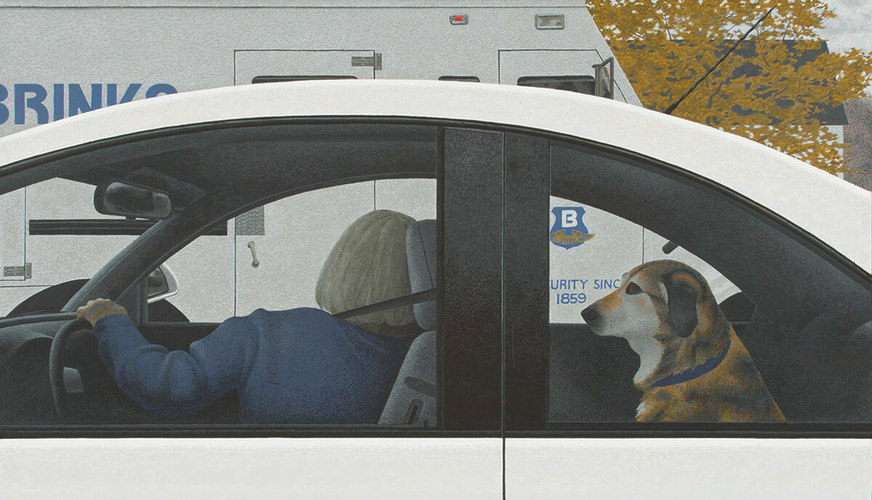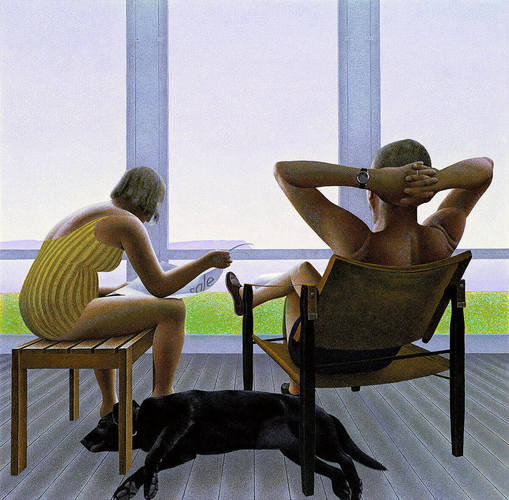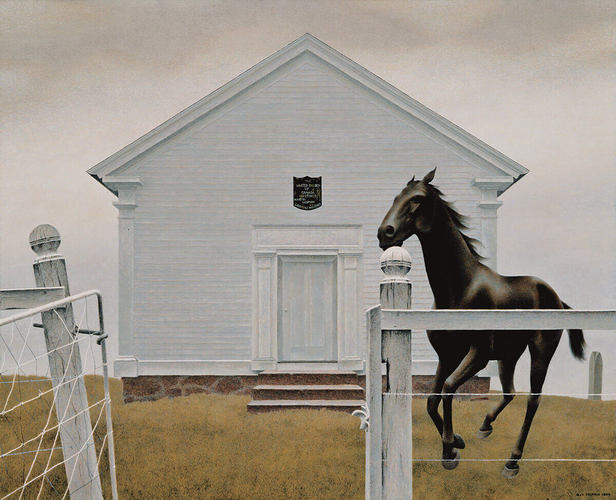Animals play a key role in the art of Nova Scotia painter Alex Colville (1920–2013), often standing in as a counter to human figures. The animal is Other, present, seemingly ubiquitous in Colville’s imagery, but essentially unknowable. As his daughter, Ann Kitz, told curator Andrew Hunter, “He wasn’t sentimental about animals, but he thought that they were essentially good, and he didn’t think that people were inherently good.” Colville uses animals as a compositional pairing—such as in Dog and Groom, 1991—that forms an essential binary in his work: human/animal or, perhaps more accurately, culture/nature. For Colville, humans think, animals act, and in their juxtaposition something important about the world can be expressed. As Hunter notes, “Colville’s bond with animals (particularly the family dogs that appear in so many works) was genuine and consistently evident. He seemed to think both about and with them, to work toward understanding the world in tandem with them.”
-article-image.jpg)
Alex Colville, Dog and Groom, 1991
Acrylic polymer emulsion on hardboard, 62.4 x 72 cm, private collection
For Colville, so influenced by existentialism and its restless pursuit for the meaning of human nature, animals provide a foil to further his philosophical engagement. As he stated early in his career: “The great task which North American artists have to perform is one of self-realization, but a self-realization much broader and deeper than the purely personal or subjective. The job thus involves answering such questions as, ‘Who are we? What are we like? What do we do?’” Colville posed these questions through the use of symbols: “I am suggesting that primeval myths may be of use to the modern painter.… What I have in mind is the use of material so old, so often used down through the ages, that it has become an integral part of human consciousness.”

Acrylic polymer emulsion on hardboard, 36 x 62.4 cm, Art Gallery of Nova Scotia, Halifax
Colville’s interest in animals can be tied to the fact that he was a thinker as much as a maker, and his sustained, rigorous approach to creating images is a remarkable legacy. His abiding interest in the nature of being led him to examine the everyday facts of existence. His subject matter is, almost exclusively, the daily life that surrounded him, whether that was in Sackville, Wolfville, or while he was on a sojourn in Santa Cruz or Berlin. For Colville, thinking deeply happens wherever you are, and happens best with familiar things. As art historian Martin Kemp notes, “He is a local painter in the sense that [painter John] Constable was local, creating art that has to draw nourishment from scenes known intimately in order to find a wider truth.”

Acrylic polymer emulsion on Masonite, 80 x 80 cm, private collection
In Colville’s depictions, simple binaries create complex images that resist easy summation. Humans and animals, men and women, humans and machines, the constructed world and the natural environment, are all put into play in his “fictions.” He begins with ideas, and uses familiar objects to express them. According to Colville, “My paintings begin as imaginary drawings, and then at a later point in their development, I make some drawings from life, from reality. It’s interesting that the original conception of one of my paintings, or my prints, always emerges out of my head, rather than from something specifically seen. It’s a sort of conglomeration of experience and observation.”

Acrylic on hardboard, 55.5 x 68.7 cm, Montreal Museum of Fine Arts
This Essay is excerpted from Alex Colville: Life & Work by Ray Cronin.
 Karen Tam’s Autumn Tigers
Bridging Past and Present: Invisible Made Visible
By Imogene L. Lim, PhD
Karen Tam’s Autumn Tigers
Bridging Past and Present: Invisible Made Visible
By Imogene L. Lim, PhD
 The Frontier Portraits of C.D. Hoy
A Chinese Canadian Photographer’s Tribute to His Community
By Faith Moosang
The Frontier Portraits of C.D. Hoy
A Chinese Canadian Photographer’s Tribute to His Community
By Faith Moosang
 Interrogating Identity
Suzy Lake explores the role of photography in shaping how we understand and see ourselves
By Erin Silver
Interrogating Identity
Suzy Lake explores the role of photography in shaping how we understand and see ourselves
By Erin Silver
 An Emboldened Artist
How Oviloo Tunnillie achieved rare international acclaim as an Inuit female sculptor
By Darlene Coward Wight
An Emboldened Artist
How Oviloo Tunnillie achieved rare international acclaim as an Inuit female sculptor
By Darlene Coward Wight
 Painting the Cultural Mosaic
William Kurelek traversed the country in a quest to capture its diverse inhabitants
By Andrew Kear
Painting the Cultural Mosaic
William Kurelek traversed the country in a quest to capture its diverse inhabitants
By Andrew Kear
 Domestic Discontent
Mary Pratt’s poetic scenes of home life are praised for their political edge
By Ray Cronin
Domestic Discontent
Mary Pratt’s poetic scenes of home life are praised for their political edge
By Ray Cronin
 A New Vision of the North
Annie Pootoogook’s art offers unprecedented insights into the contemporary Arctic
By Nancy G. Campbell
A New Vision of the North
Annie Pootoogook’s art offers unprecedented insights into the contemporary Arctic
By Nancy G. Campbell
 Meetings of Minds
Sorel Etrog found new ideas in collaborative work
By Alma Mikulinsky
Meetings of Minds
Sorel Etrog found new ideas in collaborative work
By Alma Mikulinsky
 Introducing Miss Chief
An excerpt from the ACI’s book “Revision and Resistance”
By Shirley Madill
Introducing Miss Chief
An excerpt from the ACI’s book “Revision and Resistance”
By Shirley Madill
 A Practice of Recovery
An excerpt from the ACI’s book “Revision and Resistance”
By Sasha Suda
A Practice of Recovery
An excerpt from the ACI’s book “Revision and Resistance”
By Sasha Suda
 Decolonizing History Painting
An excerpt from the ACI’s book “Revision and Resistance”
By Ruth B. Phillips and Mark Salber Phillips
Decolonizing History Painting
An excerpt from the ACI’s book “Revision and Resistance”
By Ruth B. Phillips and Mark Salber Phillips
 A Vision for the Future
An excerpt from the ACI’s book “Revision and Resistance”
By Nick Estes
A Vision for the Future
An excerpt from the ACI’s book “Revision and Resistance”
By Nick Estes
 Inside Kent Monkman’s Studio
An excerpt from the ACI’s book “Revision and Resistance”
By Jami C. Powell
Inside Kent Monkman’s Studio
An excerpt from the ACI’s book “Revision and Resistance”
By Jami C. Powell
 The Rule of Chance
Jean Paul Riopelle’s break with Automatism
By François-Marc Gagnon
The Rule of Chance
Jean Paul Riopelle’s break with Automatism
By François-Marc Gagnon
 From Taos to New York
Agnes Martin and the currents of American Art
By Christopher Régimbal
From Taos to New York
Agnes Martin and the currents of American Art
By Christopher Régimbal
 An Artist Blooms
Mary Hiester Reid’s floral aesthetics
By Andrea Terry
An Artist Blooms
Mary Hiester Reid’s floral aesthetics
By Andrea Terry
 The Patriotic Painter
Greg Curnoe’s Canada
By Judith Rodger
The Patriotic Painter
Greg Curnoe’s Canada
By Judith Rodger
 Walking, Stacking, Dancing
Françoise Sullivan’s conceptual 1970s
By Annie Gérin
Walking, Stacking, Dancing
Françoise Sullivan’s conceptual 1970s
By Annie Gérin
 The Extraordinary North
Tom Thomson’s diary of landscape
By David P. Silcox
The Extraordinary North
Tom Thomson’s diary of landscape
By David P. Silcox
 A Champion of Abstraction
Jock Macdonald sought a new expression in art
By Joyce Zemans
A Champion of Abstraction
Jock Macdonald sought a new expression in art
By Joyce Zemans